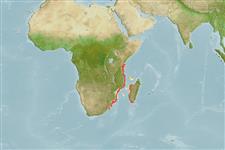Common names from other countries
Environment: milieu / climate zone / depth range / distribution range
Écologie
; profondeur 180 - 750 m (Ref. 106911), usually 400 - 500 m (Ref. 106911). Tropical, preferred 26°C (Ref. 107945); 3°S - 33°S, 31°E - 46°E (Ref. 4)
Distribution
Pays | Zones FAO | Écosystèmes | Occurrences | Introductions
Southwest Atlantic and Indo-West Pacific: from Kenya to Natal.
Length at first maturity / Taille / Poids / Âge
Maturity: Lm 4.9, range 3 - ? cm Max length : 20.5 cm TL mâle / non sexé; (Ref. 122061); 20 cm TL (female)
It has a maximum total length of 20.5 cm (male) and 20 cm (female); and carapace lengths of 4.5 to 8.8 cm (male) and 3.7 to 8.3 (female). Minimum depth range from Ref. 122059. Occurs at depths from 200 to 750 m, but most common between 400 and 500 m (Ref. 4). Occurs along the edge of the continental slope on soft muddy substrata (Ref. 106911).
Life cycle and mating behavior
Maturité | Reproduction | Frai | Œufs | Fécondité | Larves
Ovigerous females between December and June (Ref. 4).
Holthuis, L.B. 1991. (Ref. 4)
Statut dans la liste rouge de l'IUCN (Ref. 130435)
statut CITES (Ref. 108899)
Not Evaluated
Not Evaluated
Utilisations par l'homme
Pêcheries: commercial
FAO - pêcheries: landings | FishSource | Sea Around Us
Outils
Plus d'informations
Taille/Âge
Croissance
Longueur-poids
Longueur-longueur
Morphologie
Larves
Abondance
Sources Internet
Estimates based on models
Preferred temperature
(Ref.
115969): 10 - 12.3, mean 11.4 (based on 9 cells).
Résilience
Haut, temps minimum de doublement de population inférieur à 15 mois (K=0.45-0.48).
Vulnérabilité
Low vulnerability (11 of 100).
